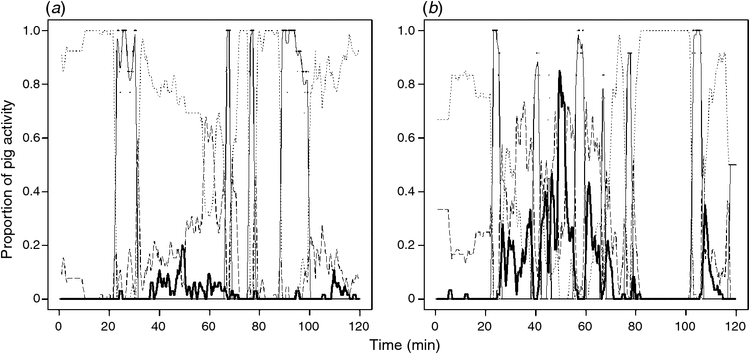Play behaviour in piglets is infrequent and not altered by enrichment with lucerne when measured by scan sampling
J. Zemitis A , K. J. Plush A B , C. R. Ralph A , R. S. Morrison C , S. Hazel D and R. E. Doyle E FA Animal Welfare Science Centre, South Australian Research and Development Institute, Roseworthy, SA 5371.
B SunPork Solutions, Wasleys, SA 5400.
C Rivalea (Australia), Corowa, NSW 2646.
D Animal Welfare Science Centre, The University of Adelaide, Roseworthy, SA 5371.
E Animal Welfare Science Centre, The University of Melbourne, Parkville, VIC 3010.
F Corresponding author. Email: rebecca.doyle@unimelb.edu.au
Animal Production Science 57(12) 2447-2447 https://doi.org/10.1071/ANv57n12Ab046
Published: 20 November 2017
Play behaviour in early life may have an important role in the cognitive and social development of piglets. Research also supports play as a potential positive welfare indicator (Brown et al. 2015). Environmental enrichment can provide opportunities to express exploratory behaviours that could lead to increased play behaviour. Our aim was to determine the effects of access to lucerne on piglet play. The hypothesis was that the provision of lucerne throughout lactation would increase play behaviour in piglets. Approximately 1 kg of lucerne hay was added to the farrowing crate daily for the first week of lactation, then every second day until weaning. Piglets from nine control litters (n = 98) and 13 enriched litters (n = 141), born across several days, were recorded for 24 h on a set day, 2 weeks after the farrowing period begun. Behavioural analysis was carried out for 2 h of video footage (11:00 to13:00) for all litters by instantaneously sampling every 15 s. Behaviours expressed were grouped into; play, active, rest or nursing, and were mutually exclusive to one another. Piglets were not individually identified, but each piglet was nominated to one of the behaviour groups at each sample point. Binominal generalized linear mixed models with treatment and piglet age, and their interaction, fitted as factors and sow as a random factor were used to analyse incidents of play, nursing and active behaviours (Bates et al. 2014). Analyses were performed in R (R v3.3.2; R Core Team 2017). Treatment did not statistically influence any of the behaviours (P > 0.05). Age influenced nursing (P = 0.016) and play (P = 0.04), but the relationships were not linear. Behaviour varied widely between litters (Fig. 1). The occurrences of play were low and occurred sporadically, but, observationally, they appeared more common after a nursing event.
Contrary to the hypothesis and other published literature on environmental enrichment provided during lactation (Martin et al. 2015), the provision of lucerne did not increase play behaviour in piglets. The short intervals of scan sampling did identify play behaviour, but it was highly infrequent. Continuous observations or assessing behaviour at other time points during the day when pigs are active would provide a more comprehensive analysis and would give further insight on treatment effects.
References
Bates D, Mächler M, Bolker B, Walker S (2014) Journal of Statistical Software 67, 1–48.Brown SM, Klaffenbock M, Nevison IM, Lawrence AB (2015) Applied Animal Behaviour Science 172, 17–25.
| Crossref | GoogleScholarGoogle Scholar |
Martin J, Ison S, Baxter EM (2015) Applied Animal Behaviour Science 163, 69–79.
| Crossref | GoogleScholarGoogle Scholar |
R Core Team (2017) R: a language and environment for statistical computing. (R Foundation for Statistical Computing: Vienna, Austria)
Supported by Pork CRC Limited Australia. Thanks to Tanya Nowland and Serena Barnes for technical support.



